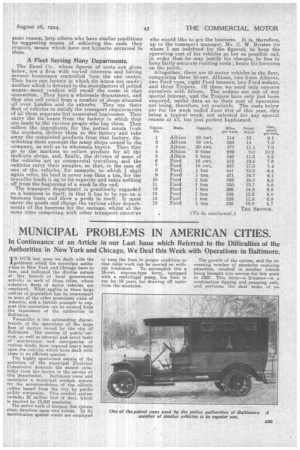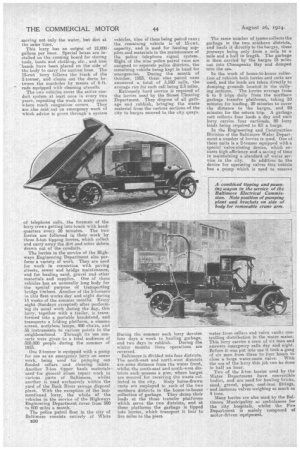MUNICIPAL PROBLEMS IN AMERICAN CITIES.
Page 13

Page 14

If you've noticed an error in this article please click here to report it so we can fix it.
In Continuance of an Article in our Last Issue which Referred to the Difficulties of the Authorities in New York and Chicago, We Deal this Week with Operations in Baltimore.
IN OUR last issue we dealt with the problems which the municipal authorities in New York and Chicago have to face, and indicated the diverse nature of this branch of local government activity in each of these cities, where extensive fleets of motor vehicles are employed. What applies in these large centres of population has its counterpart in most of the other prominent cities of America, and a further example to support this contention can be secured from the experience of the authorities in Baltimore.
Versatility is the outstanding characteristic of the operations of the large fleet of motors owned by the city of Baltimore. The routine of public -service, as well as tinnsual and novel tasks of ' maintenance and emergencies of various kinds, have imposed heavy tests opon the vehicles which have dealt with them in an efficient manner.
The highly specialized nature of the activities of the municipal Electrical Commission demands the utmost reliability from the lorries in the service of this department. Baltimore owns and maintains a municipal conduit system for the accommodation of the electric cables leased from the city by public utility companies. This conduit system includes 20 million foot of duct, which is reached by 12,000 manholes. The entire work of keeping this system clean devolves upon two lorries. In its maintenance special crews arc employed to keep the lines in proper condition so that cable work can be carried on with out hindrance. To accomplish this a 15-cwt. express-type lorry, equipped with a centrifugal pump, has been in use for 10 years for drawing off water from the manholes. The growth of the system, and the increasing number of manholes requiring attention, resulted in another vehicle being brought into service for this work in 1922.. This lorry-a 2-tonner-is a combination tipping and pumping unit, and performs the dual tasks of re moving not only the water, but dirt at the same time.
This lorry has an output of 12,000 • gallons per hour. Special boxes are installed on the running board for storing tools, boots and clothing, etc., and iron bands have been placed on the side of the body to carry the suction hose. The 15-cwt lorry follows the track of the 2-tonner, and cleans out the ducts between the manholes by means of 6-ft. rods equipped with cleaning utensils. The two vehicles cover the entire conduit system at least once in every two years, repeating the work in many cases where much congestion occurs. They are also sent out on emergency work of which ,advice is given through a system of telephone calls, the foreman of the lorry crews getting into touch with headquarters every 30 minute's. The two lorries are followed in their work by three 5-ton tipping lorries, which collect and carry away the dirt and other debris drawn out of the conduits.
The lorries in the service of the Highways Engineering Department also perform a variety of work. They are used for work in connection with paving streets, sewer and bridge maintenance, and for hauling sand, gravel and other materials and supplies. One of these vehicles has an unusually long body for the speeial purpose of transporting bridge timbers. Another of the 5-tonners in this fleet works day and night during 14 weeks of the summer months. Every night (Sundays excepted) after performing its usual work during the day, this lorry, together with a trailer, is transformed into a portable bandstand, and transports a folding platform, a. cinema screen, acetylene lamps, 400 chairs, and 35 instruments to various points in the
neighbourhood. Through its use concerts were given to a total audience of 500,000 people during the summer of 1923.
One 2-tonner is equipped with a pump for use as an emergency lorry on sewer work, being used for pumping out flooded cellars and cleaning inlets. Another 2-ton tipper hauls materials used for general street repair work to various parts of Baltimore, whilst i another s used exclusively within the yard of the Back River sewage disposal plant. With the exception of the lastmentioned lorry, the whole of the vehicles in the service of the Highways Engineering Department cover from 500 to 600 miles a month.
The police patrol fleet in the city of Baltimore consists entirely of White B30
vehicles, nine of them being patrol vans; the remaining vehicle is a 15-cwt. capacity, and is used for hauling supplies and materials in the maintenance of the police telephone signal system. Eight of the nine police patrol yens are assigned to separate police districts, the remaining vehicle being kept in hand for emergencies. During the month of October, 1923, these nine patrol vans answered a total of 3,590 calls, the average run for each call being 2.3 miles.
Extremely hard service is required of the lorries used by the Street Cleaning Department. They dispose of all garbage and rubbish, bringing the waste material from the various sections of the city to barges moored to the city quays.
During the summer each lorry devotes four days a week to hauling garbage, and two days to rubbish. During the winter months these operations are reversed.
Baltimore is divided into four districts. The north-east and north-west districts are some distance from the water front, whilst the south-east and south-west districts each possess a pier, where barges are moored for receiving the waste col
lected in the city. Sixty horse-drawn carts are employed in each of the two northern districts in the house-to-house collection of garbage. They dump their loads at the three transfer platforms which serve the two districts, and at these platforms the garbage is tipped into lorries, which transport it four to five miles to the piers. The same number of teams collects the garbage in the two southern districts, and hauls it directly to the barges, these journeys being only from a mile to a mile and a half in length. The garbage is then carried by the barges 18 miles out into Chesapeake Bay and dumped into the sea.
In the work of house-to-house collection of rubbish both lorries and carts are used, and the loads are taken directly to dumping grounds located in the outlying sections. The lorries average from 6 to 8 trips daily from the northern garbage transfer platforms, taking 20 minutes for loading, 20 minutes to cover the distance to the barges, and 20 minutes for the return trip. A garbage cart collects four loads a day and each lorry carries four cartloads, 80 lorry loads being required to fill a barge.
In the Engineering and Construction Division of the Baltimore Water Department a number of lorries is used. One of these units is a 2-tonner equipped with a special valve-closing device, which ensures high efficiency and a saving of time in maintaining a standard of water ser vice in the city. In addition to the device for operating valves this vehicle has a pump which is used to remove water from cella ts and valve vaults controlling distribution in the water mains. This lorry carries a crew of six men and answers emergency calls day and night. Before it was put into use it took a gang of six men from three to four hours to close a large Water-main Valve. With the use of the lorry this job can be done in half an hour.
Two of the 5-ton lorries used by the Water Department have convertible bodies, and are used for hauling bricks, sand, gravel, pipes, cast-iron fittings, and immense valves weighing as much as 4 tons.
Many lorries are also used by the Baltimore Municipality as ambuianees for the city hospitals, whilst the Fire Department is mainly composed of motor-driven equipment.






























